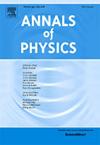Modeling anisotropic dark energy self-gravitating stars satisfying the Karmarkar condition
IF 3
3区 物理与天体物理
Q2 PHYSICS, MULTIDISCIPLINARY
引用次数: 0
Abstract
This article introduces a simplified model of static, spherical stellar systems interacting with anisotropic dark energy, using the Buchdahl model as the background metric potential. The notion of cosmic dark energy may serve as a potential mechanism to counteract the relativistic gravitational collapse of stellar distributions into singularities. Dark energy plays a vital role in shaping the cosmos on the largest scales, as it is the driving force behind the observed accelerated expansion. Therefore, it is reasonable to think that dark energy influences the kinematics of gravitationally bound stellar structures (Sakti and Sulaksono, 2021) [65]. Motivated by this, we introduce a self-gravitating stellar system model under the influence of dark energy, which incorporates both dark and ordinary matter. The model assumes a direct proportionality between the dark energy density and the perfect fluid density. We will then analyze the astrophysical features, including the regularity of the metric variables, density, pressure, mass–radius relationship, stability, dark energy parameters, and equilibrium conditions associated with the model. The model is promising due to its adherence to energy conditions and lack of a central singularity. By examining a mass–radius diagram, we have found the maximum mass limit for this type of star. Our results show that our suggested model corresponds to a feasible and physically realistic star structure that satisfies all stability criteria.
求助全文
约1分钟内获得全文
求助全文
来源期刊

Annals of Physics
物理-物理:综合
CiteScore
5.30
自引率
3.30%
发文量
211
审稿时长
47 days
期刊介绍:
Annals of Physics presents original work in all areas of basic theoretic physics research. Ideas are developed and fully explored, and thorough treatment is given to first principles and ultimate applications. Annals of Physics emphasizes clarity and intelligibility in the articles it publishes, thus making them as accessible as possible. Readers familiar with recent developments in the field are provided with sufficient detail and background to follow the arguments and understand their significance.
The Editors of the journal cover all fields of theoretical physics. Articles published in the journal are typically longer than 20 pages.
 求助内容:
求助内容: 应助结果提醒方式:
应助结果提醒方式:


